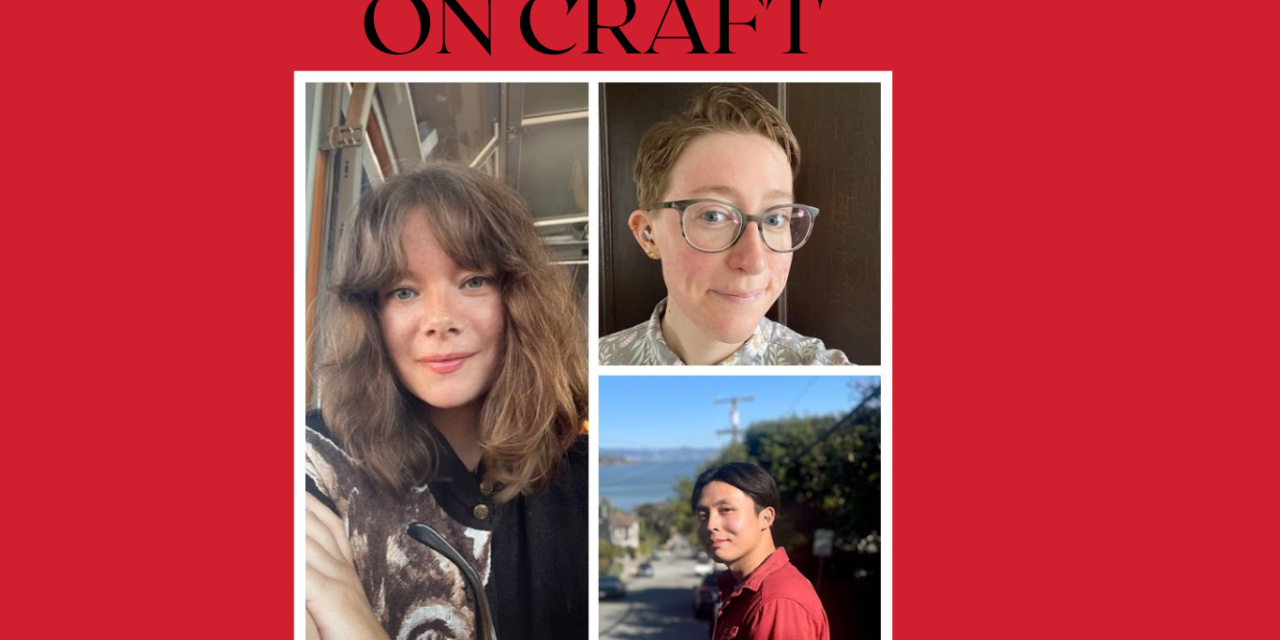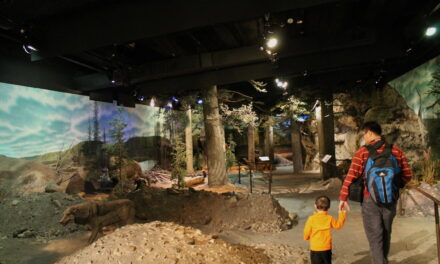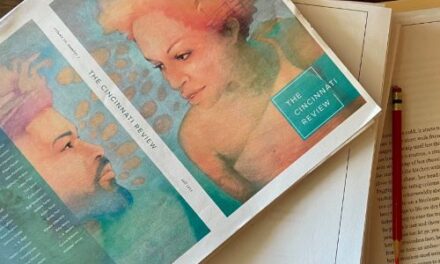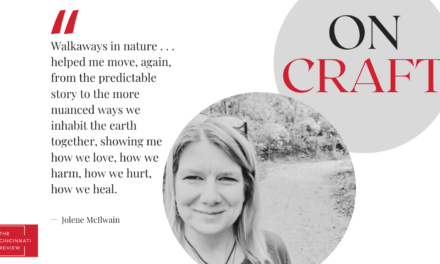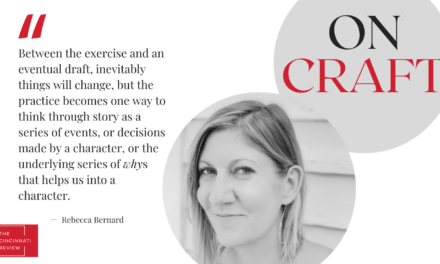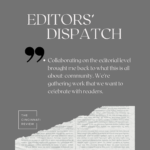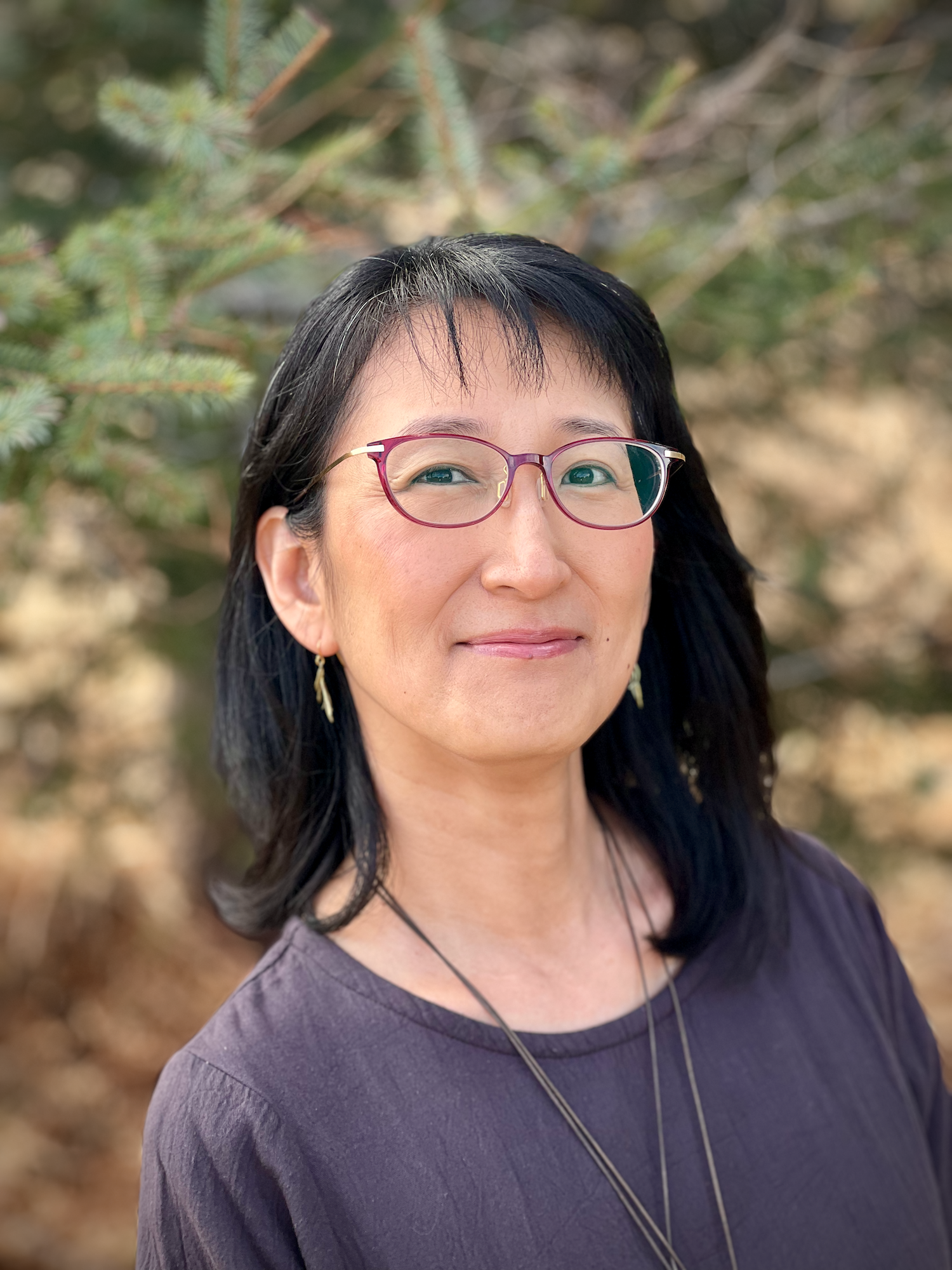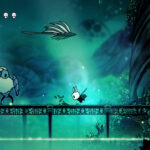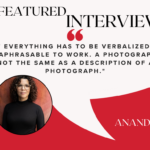Managing Editor Lisa Ampleman: Things are humming at the CR now, with all our editors back at work. In addition to the permanent staff (myself, Matt O’Keefe, and Bess Winter), we have three assistant or associate editors, all students in the doctoral program at the University of Cincinnati. I asked them, as a way of introduction (or reintroduction), to write a short meditation on craft related to beginnings or their work at the magazine:
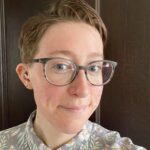
Associate Editor Lily Davenport (she/her) is a PhD candidate in fiction at the University of Cincinnati. She has an MFA from the University of Alabama, where she also served as fiction editor for the Black Warrior Review. Her work has appeared or is forthcoming in SWING, BOOTH, Quarterly West, and elsewhere.
Lily: I’ve been seeing a lot of voicey stories in the queue so far this season, and a lot of stories that put the form front and center: epistolaries, found texts, multiple or rotating narrators, playful takes on paragraph shapes and white space. This has been exciting and fun—I wrote on the CR blog last year that I hoped to see some epistolary work!—and, especially since these are also elements I’m using in my dissertation project, it’s prompted me to reflect more on the relationship between voice and form.
There’s a common lit-world perception that amping up voice and/or form means sacrificing something else: conflict, emotional charge, legibility. I don’t buy the form/feeling dichotomy; just look at Percival Everett’s Erasure (2001), which seethes with richly complex and emotional conflict and an amazing multiplicity of forms (including, but not limited to, a full-length novella, a conference paper, a CV, journal entries, notes to unfinished stories, and interview transcripts). Maybe its narrator, Monk, would describe himself as reserved or unfeeling—he’s certainly a champion intellectualizer who takes refuge in theoretical abstraction when the world becomes too fraught—but the novel’s construction belies that characterization.
All of that said: It is true that prominent use of such techniques takes up bandwidth, that to employ them is to direct the reader’s energy or attention away from something else. (As our fiction editor, Michael Griffith, often puts it in his workshops: it’s “spending complications.”) In Erasure, Everett sacrifices access to other characters’ interiority; all the novel’s artifacts underscore the fact that we’re embedded in Monk’s psyche. That strategy results in structural and formal opportunities that would otherwise be cumbersome or impossible, but it also prevents us from experiencing the story’s other inhabitants on their own terms, or getting a reality check on some of Monk’s narration.
This is similar to the trade-off I’m making in my own work right now, and to some of those I’ve seen recently in the queue: when you turn a narrator’s voice up louder, unwanted ambiguities can creep through in the static. It’s possible to get the reader to spend so much mental energy keeping up with the voice, or the form in which that voice presents itself, that they don’t have anything left over to evaluate that voice’s position within the world of the story (or, sometimes, its relationship to our own world, in which the story was written). This can be a difficult tightrope, but it’s still worth walking; I’m looking forward to reading more voice-driven, form-forward stories in the coming year!
Assistant Editor Andy Sia is a poet from Brunei. He received his MFA from the University of Mississippi, where he served as senior editor for Yalobusha Review, and is currently a fourth-year PhD candidate at the University of Cincinnati.

On Entering a Poem: Reading Mei-mei Berssenbrugge
Mei-mei Berssenbrugge’s “Green” begins: “It’s quiet in the pine woods, pine cones falling on pine needles.”
So, the beginning is quiet.
Quietude places emphasis on the visuality of woods; I see the pine woods as a crystalline image.
This is not a static image; it moves within the span of the sentence.
I move with it, closing in on the minutiae of cone and needle from the broad sweep of woods.
Movement of cone against needle: part of the woods’ quietude, or rupture?
Slight as the sound must be, rupturing pine woods’ almost-unreal quiet.
Also—literal fall?
Alternatively: falling motion as when cone brushes against needle (wind? animal overhead?).
Further openings along the line.
I attempt the sensory complexities a poem permits.
Felt potentials.
Eventually, the speaker walks into an area where “foliage is not so dense, maples, beeches, aspen.”
As do I—“I.”
Greenness amplifies.
It slides across shades and hues—as “emerald greens, yellow greens, blue greens, gray green”— kaleidoscoping around the general form of green.
So, green is touchy, deepening into itself as emerald or diluting into yellow or blue; blue greens=leaves shading into the sky, making contact?
Then, the “green cave” of the woods is not just a transformative medium, highlighting and drawing out changes in things within it, as when “[a] bug turns into the tip of a blade of grass.”
The medium itself is subject to change.
The medium is change.
Reading, as walking, is an exercise in sensory excess.
The touching-seeing-hearing synesthetically encodes in my body; it encodes the body.
I read and (to?) feel my body surface.
I read on the bench by Graeter’s Ice Cream (Clifton branch; Cincinnati), chilled by my cup of salted caramel ice cream even as the sun is up.
I read perched on my couch by the windowsill on my ground-floor apartment, green stalks tapping at the window.
I read in a corner of the library under an electrical hum like snow.
So many openings congruent with others!
Berssenbrugge: “I walked through the forest with the same rapture as I have since, but I had not yet tried to describe it, it was felt.”
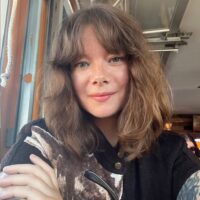
Assistant Editor Kate Jayroe is an editor and creative writing instructor in Cincinnati. Work by Kate appears in The Gettysburg Review, Hayden’s Ferry Review, XRAY, Joyland, Vol. 1 Brooklyn, Tammy, The Fanzine, and more. katejayroe.com
Kate: Cincinnati is a city rife with vanity license plates! Each occasion of driving presents the watchful eye with many a sassy, short missive in all caps. On a balmy Saturday in Northside, I saw a blue Honda Fit, well parallel parked. Its license plate: ZORSE. The word stuck to the ribs of my mind, and I found myself chanting the word “zorse” and then inserting it into my own version of the ACE Hardware jingle (Zorse is the source for the healthy hardware horse). Cursory research taught me that the zorse comes from a zebra stallion and horse mare, and that a zorse is infertile. In a story I had been drafting, a young woman realizes her dream job is a dead end, and her crush is not a suitable suitor. In this sense, I felt a zorse-ish presence peeking its way into the work, which I titled, “Zorse.” I found that the concept of a zorse could fill out each and every line, character, and movement of the story with a deeper significance, a creative resonance that took the draft closer and closer to a moving, working story.
When I write, I find that the pressure of plucking one idea and then expounding upon it can cause me to freeze up, go for a walk instead. To avoid this phenomenon, I find my way into one creative channel and take that channel as far as I can. In the way we consciously shift and change our wardrobe to the season, so too do I try my best to follow the season of my own creative efficacies. Lately, the channel has been the title. In this sense too, the title is my beginning. It is the overcoat of the story, the item first encountered by a reader.
Sometimes, the idea of a beginning can be misleading, particularly when it comes to a timeline of conception, drafting, execution. Rather, a beginning can be an effective and artistic container for one’s delightfully singular vat of brain goo. In this sense, the beginning of a piece of writing can give the reader an opening and comprehensive glimpse. It can be an accurately scaled model airplane. You get the main conceit, even some unique themes or details as well, but it is presented in this compressed, tantalizing format.
A beginning does not necessarily constitute a creative starting point!

